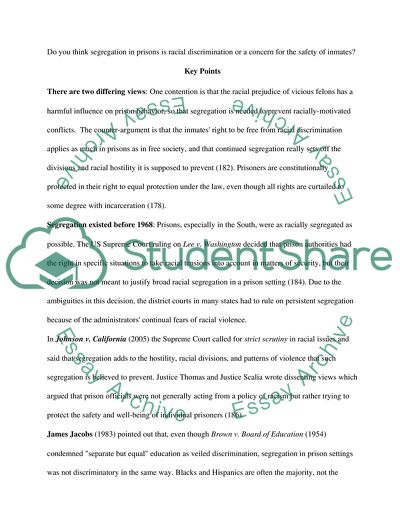
- Home
- Free Samples
- Premium Essays
- Editing Services
- Extra Tools
- Essay Writing Help
- About Us
- Studentshare
- Subjects
- Miscellaneous
- A Failure to Integrate: Equal Protection and Race in American Prisons
A Failure to Integrate: Equal Protection and Race in American Prisons - Essay Example

- Subject: Miscellaneous
- Type: Essay
- Level: Masters
- Pages: 4 (1000 words)
- Downloads: 0
- Author: shammes
Extract of sample "A Failure to Integrate: Equal Protection and Race in American Prisons"
Race belongs to one of the classifications that fall under suspect, so all of the decisions in the history of the Supreme Court and the lower district courts come under the strict scrutiny standard that will allow segregation temporarily for security and safety only in very limited cases. In the prison setting the topic of racial segregation has been fiercely debated for many years because of the fears of prison administrators that desegregation will increase race-based violence. In other areas the courts have left a lot up to prison administrators, but on the issue of racial segregation the courts have consistently refused to allow a lower standard of scrutiny.
Desegregation has been achieved in varying degrees across the country over the last few years, and the feared increase of racial conflicts has not really happened. Some studies in certain states show that racial desegregation has even reduced racial tensions in the larger prison population. There are two differing views: One contention is that the racial prejudice of vicious felons has a harmful influence on prison behavior, so that segregation is needed to prevent racially-motivated conflicts.
The counter-argument is that the inmates right to be free from racial discrimination applies as much in prisons as in free society, and that continued segregation really sets off the divisions and racial hostility it is supposed to prevent (182). Prisoners are constitutionally protected in their right to equal protection under the law, even though all rights are curtailed to some degree with incarceration (178). Segregation existed before 1968: Prisons, especially in the South, were as racially segregated as possible.
The US Supreme Court ruling on Lee v. Washington decided that prison authorities had the right in specific situations to take racial tensions into account in
...Download file to see next pages Read MoreCHECK THESE SAMPLES OF A Failure to Integrate: Equal Protection and Race in American Prisons
Better Prison Systems and Protection for Inmates That Cooperate
Helping Native Americans and Their Fight with Alcoholism
The historical progression of African Americans
Prison Population The Elderly
Multiculturalism Has Many Definitions
Fighting the Issue of Alcoholism among Native American Population
Murder on a Sunday Morning by Jean-Xavier de Lestradeis
Solutions to X Refinery Problems

- TERMS & CONDITIONS
- PRIVACY POLICY
- COOKIES POLICY